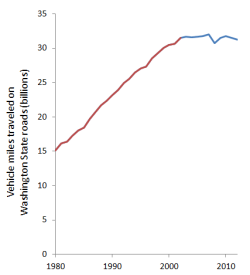Vehicle travel on Washington’s state roads fell again last year. It was a modest decline—just 0.8 percent—but as the chart to the right shows, it was a continuation of a full decade of essentially flat traffic. In fact, WSDOT estimates that total traffic on state roads was slightly lower in 2012 than it was in 2002.
There’s really not much to say about the trends that I haven’t said before. The flat-lining of traffic is due not to one single factor, but to many. Higher fuel prices are discouraging driving. Baby boomers have aged past their peak driving years. The “millennial” generation is driving less. Mobile and internet technologies make transit more convenient and rewarding. And the popularity of compact neighborhoods lets more people live in places where they don’t need to drive much.
And of course, I should mention a key fact that is getting overlooked in today’s transportation debates: the flat-lining of vehicle travel has occurred during a period when the state has done little to expand the urban highway network. And as a growing body of research suggests, driving in major metropolitan areas grows roughly in lock step with road space. Which makes me despair about the latest proposals for highway megaprojects in Washington’s major cities.


Comments are closed.